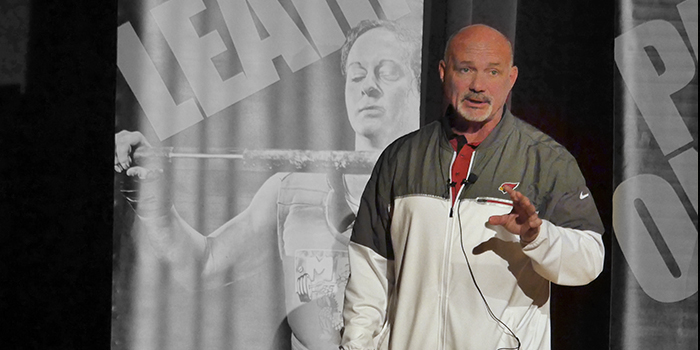
In the first two parts of his elitefts SPS Presentation, Buddy Morris began by discussing the impact of genetics and environment, explaining that the most important thing any strength coach or athlete can do is to continue to learn every single day. Buddy then followed up, in part two, by discussing gurus and gimmicks, and explained how to avoid falling victim to bad information. He detailed the importance of adjusting your plan when it becomes necessary rather than being slave to what is written on the page.
In this video, part three of Buddy's presentation, he begins by sharing a fact that may surprise you: during training camp, his skill players don't squat a single time. The reason for this is a perfect example of how important it is to account for every demand put on an athlete. During training camp, these players put so much strain on their hamstrings that squatting in training would be too much. A large portion of this muscle strain occurs during sprinting, which is the most demanding training an athlete can encounter — more than anything that happens in the weight room. In understanding this, it is important to remember that no system in the human body works independently of the other systems in the body.
WATCH: Buddy Morris SPS Presentation — Genetics, Environments, and Learning
Buddy then talks about the role the brain—not to be confused with the mind—plays in athletic performance. Every moment of stress you encounter is stress to your brain, and your body is going to respond accordingly. The only thing your brain is concerned with is how much rest it is going to get. These stressors occur even when you don't consciously think of an issue. The Unconscious Thought Theory explain this phenomenon: your brain continues to process information and deliberates regarding decisions even when you don't know that it is doing so. Your brain is always working in the background and influences every activity you engage in — including your training.
Buddy discusses all of the variables your brain controls and influences, and how managing these better can improve performance. He gives an outline for how to help your athletes' brains be more ready to handle training and performance demands. Design the training to progress through the sessions in this order:
- Slow to fast
- Simple to complex
- Easy to hard
Furthermore, when the body experiences intense levels of stress and inflammation occurs, indicators are sent to the brain that decrease intrinsic motivation to train. This occurs during periods of overtraining when your body and brain cannot adequately recover.
By the minute:
- (0:33) During camp, his skill guys don't squat. Account for every load.
- (3:31) Everything begins in the brain
- (7:40) Stress is trauma to the brain
- (11:08) The Unconscious Thought Theory
- (13:55) Bodily activities the brain controls and how it evolves
- (18:00) Every athlete moves, and all movement begins in the brain
- (21:09) Plan A, Plan B, and Plan C
- (25:00) Your program must be a living, breathing organism
- (29:02) Developing all components of power development year-round









